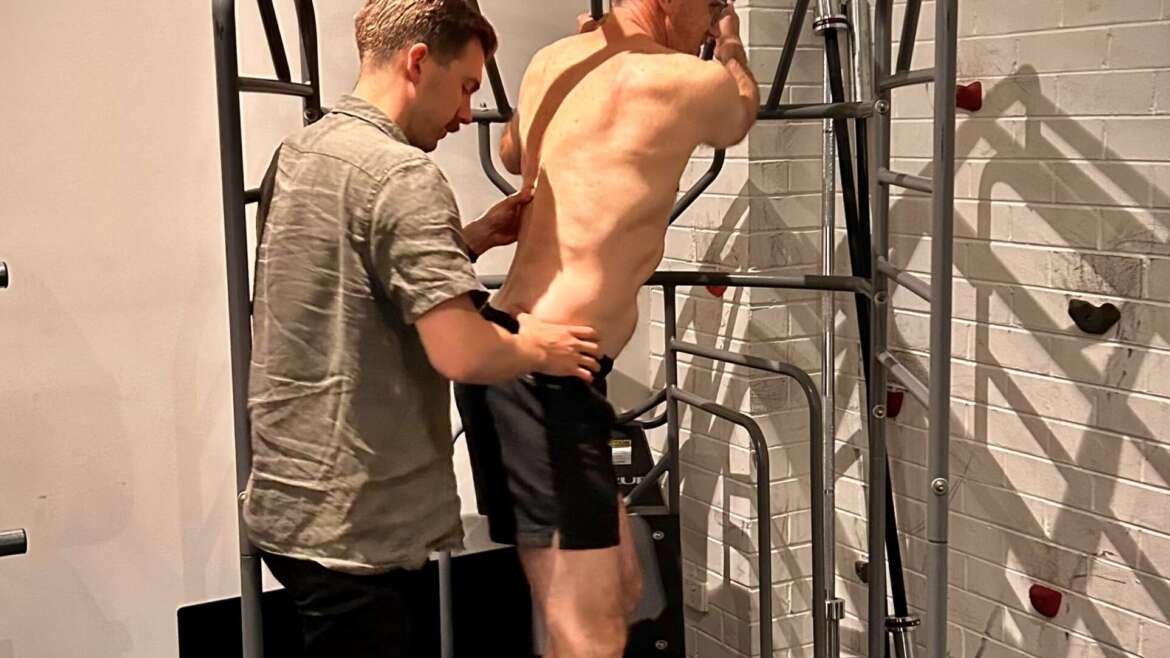Golf is a game that demands physical prowess and mental acuity, and as golfers between the ages of 30 and 60 know all too well, enjoying the sport to its fullest requires a proactive approach to preventing pain and discomfort.
Whether you hit the links two or seven times a week, implementing these five tips will help you navigate your rounds with ease and keep pain at bay.
Dynamic warm-up: The foundation of fluid swing
A dynamic warm-up is not just a formality; it’s a crucial step in preparing your body for the physical demands of a round of golf. For golfers in their 30s to 60s, muscles and joints may need a bit more TLC to function optimally.
Dynamic stretches, such as leg swings, hip circles, and torso rotations, increase blood flow, improve flexibility, and help prevent injuries during your swing.
Why:
Engaging in a dynamic warm-up enhances muscle elasticity, allowing for a more extensive range of motion. This, in turn, reduces the risk of strains and injuries, especially in the hips, shoulders, and back, areas commonly affected by the golf swing.
Proper Equipment: A Precise Fit for Pain-Free Play
Investing in properly fitted golf equipment can make a world of difference in your comfort on the course. Ensure that your clubs are suited to your height, grip size, and swing speed.
Consider using a golf ball with the right compression for your swing, as this can impact how your body absorbs the shock of impact.
Why:
Ill-fitted equipment can force your body into awkward positions, leading to muscle strain and joint stress. Conversely, properly fitted clubs and balls can enhance your swing mechanics, allowing for a smoother, more efficient motion, and reducing the strain on your body.
Mindful Pacing: Balancing Play and Rest
Golf is a marathon, not a sprint. Maintaining a consistent and mindful pace throughout your round can significantly impact your overall comfort and performance. Take breaks, stay hydrated, and avoid rushing between shots.
Why:
Overexertion can lead to fatigue, impacting your swing mechanics and increasing the likelihood of injuries. A balanced pace not only ensures you enjoy the game but also helps your muscles stay loose and responsive throughout the round.
Focus on Core Strength: The Golfer’s Powerhouse
The importance of a strong core cannot be overstated in golf. Whether driving off the tee or putting on the green, a stable core is fundamental to a powerful and controlled swing.
Why:
A robust core provides stability and support for the spine, reducing the risk of lower back pain and injuries. Incorporate core-strengthening exercises, such as planks and rotational exercises, into your fitness routine to enhance your overall golf performance.
Post-Round Stretching: A Crucial Cool Down
Once the round is over, don’t neglect the importance of a proper cool down. Stretching your muscles helps prevent stiffness and accelerates recovery, ensuring you’re ready for your next outing.
Why:
Post-round stretching aids in muscle relaxation, promotes flexibility, and helps alleviate any tension built up during the game. It’s a simple yet effective way to enhance your overall golfing experience and reduce the risk of delayed-onset muscle soreness.
Conclusion:
Golf is a lifelong pursuit, and for enthusiasts between the ages of 30 and 60, taking proactive steps to minimize pain and discomfort is essential. By incorporating these tips into your routine, you’ll not only improve your game but also ensure that every round is a pain-free, enjoyable experience.
Golf is a sport that rewards both skill and self-care, so hit the fairways with confidence, knowing that your body is ready for the challenge.
FREQUENTLY ASKED QUESTIONS
Q: Why is a dynamic warm-up important before playing golf? A dynamic warm-up increases muscle elasticity, reduces the risk of strains and injuries, and enhances flexibility, especially in areas like hips, shoulders, and back commonly affected by the golf swing.
Q: How does properly fitted golf equipment help prevent pain during play? Properly fitted clubs and balls enhance swing mechanics, reduce strain on the body, and prevent muscle strain and joint stress caused by ill-fitted equipment.
Q: Why is pacing important during a round of golf? Maintaining a balanced pace throughout the round prevents fatigue, ensures better swing mechanics, and keeps muscles loose and responsive, reducing the risk of injuries.
Q. How does core strength impact golf performance and prevent pain? A strong core provides stability for the spine, reduces the risk of lower back pain and injuries, and is fundamental for a powerful and controlled swing.
Q. Why is post-round stretching crucial for golfers? Post-round stretching aids in muscle relaxation, promotes flexibility, accelerates recovery, and reduces the risk of delayed-onset muscle soreness, ensuring a pain-free and enjoyable golfing experience.
Contact our friendly Osteo team at MOSIC. We can help you prevent or recover from your golfing injuries.

